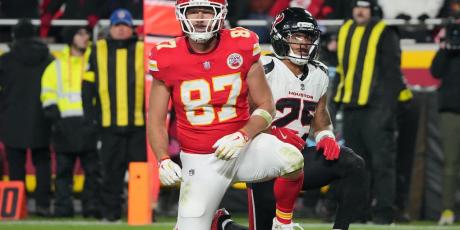The Most Predictable Running Back Stats

The middle-round running back discourse I’ve seen in recent weeks has focused on indifference. Does it even matter who you take in the middle rounds if all of these players are the same? Given the ever-rising prices of WRs, I’d argue it’s actually one of the most important aspects of drafts this season. Selecting the right middle-round RBs will super-charge a team that was able to select WRs early and still get an elite QB and TE. Let’s see if we can differentiate these RBs by digging into the statistics that are the most consistent and predictive at the position.
More Predictable Stats: QB | WR | TE
Methodology
This analysis considered 23 statistics for running backs who had at least 100 attempts in consecutive seasons. Like for quarterbacks, every statistic analyzed is a rate statistic rather than a volume statistic. For example, we’re using explosive runs per attempt rather than the total number of explosive runs in a season. This allows us to more easily compare running backs with a different number of attempts.
We’re using 2018-2023 for the time period for two reasons. The first is some advanced statistics from NFL Next Gen Stats, like rushing yards over expected (RYOE), which are only available starting in 2018. For a thorough analysis of these statistics, Matt Okada does a great job in his Understanding Next Gen Stats article. The second reason is the correlations don’t change drastically if you extend the time period.
Consistent Variables
Let’s first look at how consistent running back stats are year-over-year. The table below shows the correlation of a variable between consecutive seasons. What you’ll see is the top of the table is dominated by volume statistics. Volume remains king at the RB position. Moreover, the top three stats all revolve around the passing game. The importance of a running back’s receiving work is going to be a common theme.
Like with QBs, a running back’s TD rate is not consistent between seasons. That’s unfortunate, given the importance TD scoring has on fantasy points, particularly in half-PPR formats. However, the market is doing a good job not pricing up players with outlier TD rates last season. For example, Raheem Mostert, Kareem Hunt, Gus Edwards, and David Montgomery had four of the top five rushing TD rates in the league. None of these players are being drafted before the 7th round on Underdog.
| Variable | Correlation |
|---|---|
| Receptions Per Game | 0.70 |
| Receiving Yards Per Game | 0.68 |
| Routes Per Game | 0.64 |
| Rush Attempts Per Game | 0.61 |
| Fantasy Points Per Game | 0.57 |
| Time Behind Line of Scrimmage | 0.54 |
| Elusive Rating | 0.51 |
| Targets Per Route Run | 0.50 |
| Yards After Contact Per Attempt | 0.44 |
| Avoided Tackles Per Attempt | 0.43 |
| 8+ Defenders in the Box Rate | 0.41 |
| Yards Per Route Run | 0.39 |
| Yards Per Attempt | 0.37 |
| Breakaway Rate | 0.36 |
| Explosive Runs Per Attempt | 0.34 |
| RYOE Per Attempt | 0.33 |
| Points Earned Per Play | 0.29 |
| EPA Per Attempt | 0.22 |
| First Downs Per Attempt | 0.20 |
| Success Rate | 0.16 |
| Receiving TD Rate | 0.08 |
| Fumbles Per Attempt | 0.08 |
| Rush TD Rate | 0.05 |
Predictive Variables
The table below extends our analysis further by comparing the correlation of each variable with a running back’s fantasy points per game in the next season. Because let’s be honest, that’s what we really care about. And like the consistent variables, receiving statistics dominate the most predictive variables for running backs. After fantasy points per game, the most predictive statistics are receiving yards per game, receptions per game, routes per game, and yards per route run. We’re six variables deep before we hit a running-based statistic for running backs. The importance of receiving work cannot be overstated for RB fantasy points.
| Variable | Correlation |
|---|---|
| Fantasy Points Per Game | 0.57 |
| Receiving Yards Per Game | 0.50 |
| Receptions Per Game | 0.47 |
| Routes Per Game | 0.39 |
| Yards Per Route Run | 0.37 |
| Rush Attempts Per Game | 0.35 |
| Targets Per Route Run | 0.32 |
| Explosive Runs Per Attempt | 0.22 |
| Rush TD Rate | 0.21 |
| Yards Per Attempt | 0.20 |
| Yards After Contact Per Attempt | 0.18 |
| RYOE Per Attempt | 0.18 |
| Elusive Rating | 0.18 |
| Time Behind Line of Scrimmage | 0.16 |
| Breakaway Rate | 0.15 |
| Fumbles Per Attempt | 0.15 |
| EPA Per Attempt | 0.15 |
| Avoided Tackles Per Attempt | 0.14 |
| Points Earned Per Play | 0.13 |
| First Downs Per Attempt | 0.11 |
| Receiving TD Rate | 0.10 |
| Success Rate | 0.01 |
| 8+ Defenders in the Box Rate | -0.07 |
The complete lack of predictiveness of RB success rate is interesting. The down-to-down ability to obtain the yardage you need on a play may be beloved by a coaching staff, but fantasy managers shouldn’t care. I found something similar when looking at best ball playoff advance rates. There was no connection between taking RBs with a high prior-year success rate and advancing more teams to the playoffs of Underdog’s Best Ball Mania IV (BBMIV).
However, that’s not the case for RYOE. RYOE is skewed by big plays, as long runs make up a large portion of a running back’s yards relative to expectation. But don’t we want RBs that have that big-play ability? Each data point in the graph below is a drafter that entered BBMIV 150 times. And we’re only focusing on the drafters that tended to take RBs later in drafts. The x-axis is the RYOE per attempt of their average drafted RB, while the y-axis is the percentage of teams that drafter advanced to the playoffs. As the RYOE of a drafter’s average RB increases, so does their advance rate. And it’s a reasonably strong connection, given this is only one variable for one position group.
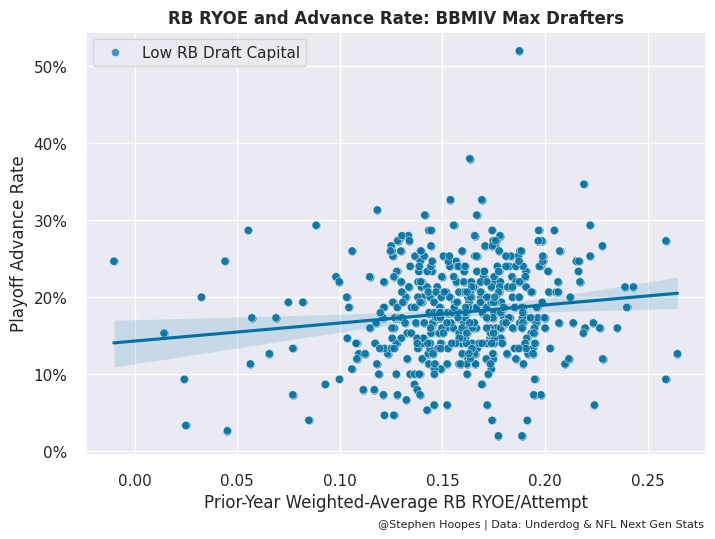
Receiving Volume
An issue with the importance of receiving volume for RBs is that the share of targets going to the RB position is in decline. Moreover, the existing volume is increasingly being split by additional players. So, we have a shrinking pie that we’re cutting into more pieces. Adding to this problem is the difficulty of taking early-round RBs, given the current WR landscape. WR prices are higher-than-ever, and the profiles of the early-round WRs aren’t available later in the draft. This means finding RBs in the later rounds with potential receiving volume is crucial.
The graph below is a partial dependence plot (PDP) of receiving yards per game. PDPs are a great way to shine some light on the inner workings of machine learning models. They show how each variable affects the model’s predictions while averaging out the effects of the other variables. It’s easiest to focus on the orange line in the graph. As that orange line increases above zero on the y-axis, it means RBs in that range typically score more fantasy points next season. The main takeaway here is that RBs with more than 20 receiving yards per game are more likely to have massive fantasy seasons the next year. Alternatively, fewer than 15 receiving yards per game is a red flag.

Unfortunately, again, the market is doing a good job of pricing RBs with receiving prowess. The average ADP of RBs that gained more than 20 receiving yards per game last year is 58 or a 5th-round pick. Meanwhile, RBs with fewer than 20 receiving yards per game have an average ADP of 129 or an 11th-round pick. But players like Aaron Jones, Tyjae Spears, and Jaylen Warren have more reasonable prices and fall into this range. I’ll dig deeper into each of these players below.
Efficiency and Explosiveness
While not as important as volume, we do want our RBs to be both efficient and explosive. The three variables associated with the most model gain in this bucket were explosive runs per attempt, yards after contact per attempt, and avoided tackles per attempt. With regard to explosiveness, we’d like our RB to have 12% or more of their carries result in explosive gains, where an explosive run is just one that gained more than 10 yards. Tyjae Spears and Jaylen Warren pop up again in this category, as does Raheem Mostert.
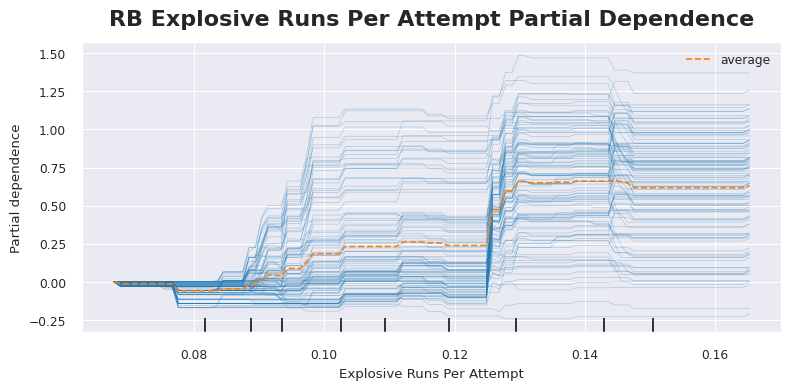
For yards after contact per attempt, we’d like our RB to exceed 2.75 yards. While the yards before contact is often a result of offensive line play, a running back has more control over their efficiency after contact. For example, De’Von Achane put up an absolutely absurd 5.12 yards after contact in 2023. But among RBs with more reasonable ADPs, Raheem Mostert, Aaron Jones, Tyjae Spears, and Jaylen Warren all fit the bill. They each finished among the top 12 RBs in this stat last year.
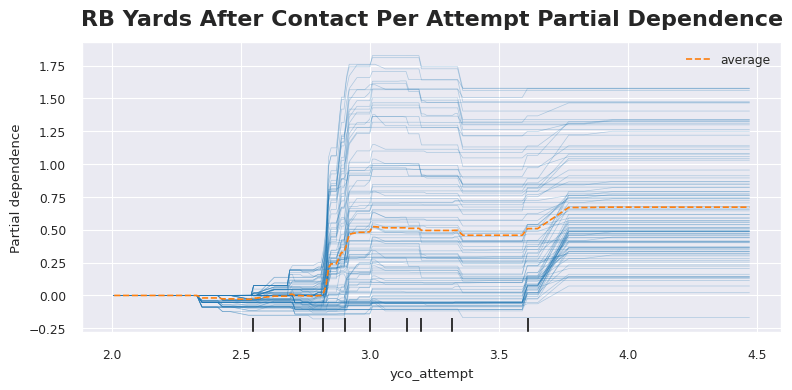
With regard to tackle avoidance, we want our RBs to avoid about one tackle for every five attempts. And ideally, they don’t fall below a 14% avoided tackle rate. You’re not going to be surprised by this, but among RBs with middle-round ADPs, Raheem Mostert, Tyjae Spears, and Jaylen Warren all stand out. They each finished in the top five last year with at least a 25% avoided tackle rate.
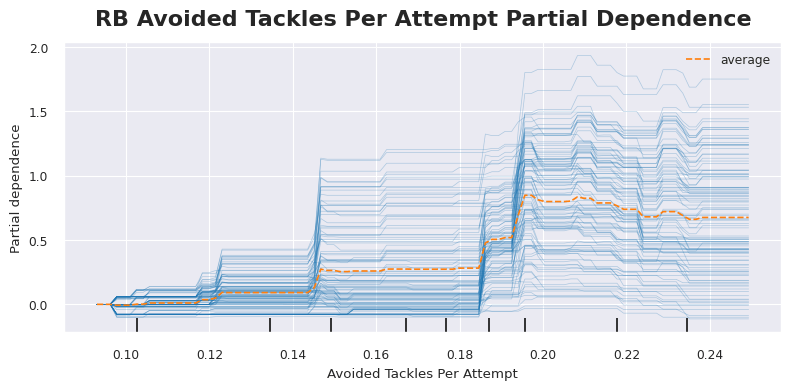
Running Backs Who Stand Out
Aaron Jones, Tyjae Spears, and Jaylen Warren
I’m grouping these three players together because they’re targets for similar reasons. All three are available in the middle rounds of drafts and have the requisite receiving volume that we care about deeply. Moreover, they flash in essentially all of the efficiency and explosiveness stats that matter. The thing standing in each of their ways is potential rushing volume. Yet, each is dealing with a significant change that has the potential to benefit them.
For Aaron Jones, it’s a new team. Matt LaFleur is ideologically set on a running back by committee. That trend, at the very least, isn’t as clear for Kevin O’Connell. It would go a long way for Jones’ fantasy output if we can bump his 13 rush attempts per game from last year above 15. Unfortunately, 4for4’s projections have him closer to 12 rush attempts per game.
Tyjae Spears’ competition has changed drastically since 2023. Derrick Henry is gone, and in his place is Tony Pollard, who had a disappointing season relative to his high expectations. Tyjae Spears hit elite marks in every single receiving volume and rushing efficiency metric that we’ve highlighted. The thing standing in his way is he only averaged about six rushing attempts per game. With an Underdog ADP of 112, I’m betting on an extremely efficient player with reduced competition seeing an uptick in volume.
Finally, Jaylen Warren has new (and hopefully improved) QB play and a new offensive coordinator. Now, Arthur Smith has a history of frustrating RB usage decisions. But we know for sure that he will want to run the ball as much as humanly possible. If you combine Warren’s elite efficiency and receiving work with a boost in rushing attempts, you get an absolute steal in the 8th round. Perhaps the Steelers will even try passing him the ball past the line of scrimmage for a change.
Raheem Mostert
I get the case against Raheem Mostert. At 32 years old, he’s about seven years older than RBs in their prime. He also has a backfield-mate in De’Von Achane, who breaks all of my RB efficiency charts. And the Dolphins just drafted an extremely fast RB named Jaylen Wright in the fourth round. But with all that said, he finished as the RB3 in fantasy points per game last year with the same age and Achane concerns. I wonder if we’re over-thinking this a bit? He was extremely efficient in all of the markers that we care about. Now, the receiving volume is absolutely a concern. But at his 9th-round price tag and with the goal line work on the elite Dolphins offense, the risk is more than baked in.
Jonathon Brooks
I wanted to bring up Jonathon Brooks here despite not having any NFL statistics on him yet. Rookie RBs with the draft capital Brooks got tend to be very successful fantasy picks in the middle rounds of drafts. The graph below shows a few key stats from Brooks’ college career. There really aren’t any holes in his profile, something that can’t be said for the other rookie RBs in this class.
However, there are two primary concerns for Brooks. The first is that he’s returning from an ACL tear that he suffered in November. As a result, he most likely won’t be fully healthy at the start of the season. The second is Brooks’ offensive environment might be lacking. But given his age, projected role, and receiving volume in college, he’s absolutely someone I’m targeting in the 8th round.
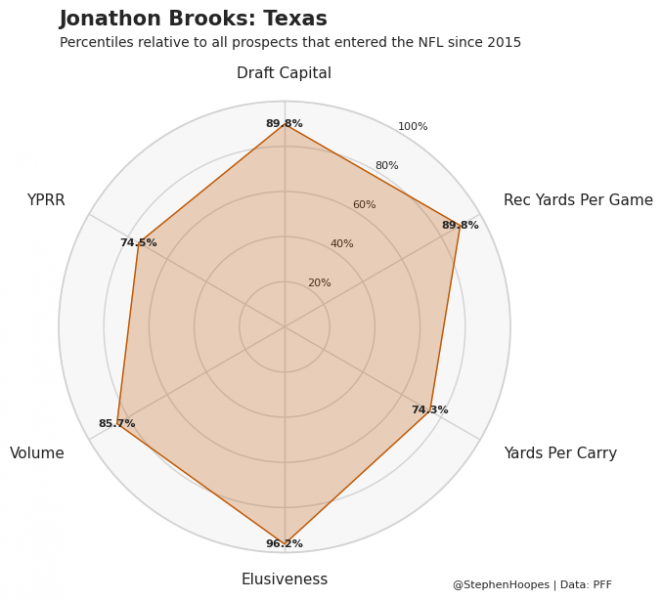
Devin Singletary
I have a hard time justifying Devin Singletary’s ADP. He is expected to be the primary back for the Giants in 2024. But he had that role for a better offense last season. And he managed only 8.7 fantasy points per game landing in the red flag areas for receiving yards, receptions, and tackle avoidance. He’s also drafted one positional spot before Tyjae Spears. I don’t see the massive upside I’m looking for with Singletary.
D’Andre Swift
After Devin Singletary, D’Andre Swift is my biggest fade stemming from this analysis. He didn’t hit the target zone for any of the variables we care about in 2023. And he was in the red flag zone for both receiving yards per game and yards after contact per attempt. He’s got actual competition behind him in both the hyper-efficient Khalil Herbert and a young back, Roschon Johnson. And he can’t really be higher than 4th on the target list behind DJ Moore, Keenan Allen, and Rome Odunze. He’s also being drafted around Aaron Jones, Jaylen Warren, and Raheem Mostert. I haven’t clicked Swift a single time in Underdog drafts.
Ty Chandler
My concern with Ty Chandler is partially due to how high I am on Aaron Jones. But there are warning signs that strictly look at Ty Chandler as well. He’s in the red flag area for every statistic we’ve looked at so far, with the exception of yards after contact per attempt. The volume wasn’t there last year, and he was inefficient on that low volume. In his range, I’m much more interested in Jerome Ford, who could be his team’s primary back for much of the season with Nick Chubb sidelined.
Bottom Line
- Volume is king for RBs, but particularly receiving volume.
- In addition to volume, we want our RBs to be both efficient and explosive. The three most valuable statistics here are explosive runs per attempt, yards after contact per attempt, and avoided tackles per attempt.
- Given the WR meta, selecting the right middle-round RBs is more important than ever.
- Target the RBs that have shown receiving ability and elusiveness with a changing situation that could provide additional rushing volume.








